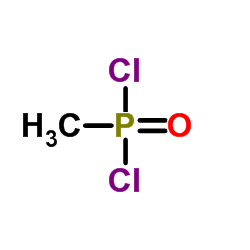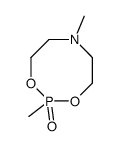676-97-1
| 中文名 | 甲基膦酞二氯 |
|---|---|
| 英文名 | Methylphosphonic Dichloride |
| 中文别名 | 二氯甲基膦 |
| 英文别名 |
EINECS 211-634-4
Methanephosphonyl chloride MFCD00002071 Methylphosphonyl dichloride Methylphosphonicdichlorid Phosphonic dichloride, P-methyl- dichlorophosphorylmethane Methyl phosphonyl dichloride |
| 密度 | 1.4±0.1 g/cm3 |
|---|---|
| 沸点 | 163.0±0.0 °C at 760 mmHg |
| 熔点 | 32-60ºC |
| 分子式 | CH3Cl2OP |
| 分子量 | 132.914 |
| 闪点 | 44.1±18.7 °C |
| 精确质量 | 131.929855 |
| PSA | 26.88000 |
| LogP | 0.25 |
| 外观性状 | 固体 |
| 蒸汽压 | 2.8±0.3 mmHg at 25°C |
| 折射率 | 1.420 |
| 储存条件 | 存放在充有干爽惰性气体的容器内,并放在阴凉,干爽处。储存的地方必须上锁,钥匙必须交给技术专家和他们的助手保管。避免湿气和水分。储存的地方远离氧化剂,切勿与氧化和酸性材料存放在一起。 |
| 稳定性 | 远离氧化物,水分,碱,活性金属。 |
| 水溶解性 | Soluble in water. |
| 分子结构 | 1、 摩尔折射率:23.25 2、 摩尔体积(m3/mol):91.9 3、 等张比容(90.2K):220.9 4、 表面张力(dyne/cm):33.3 5、 介电常数: 6、 偶极距(10 -24cm 3): 7、 极化率:9.21 |
| 计算化学 | 1.疏水参数计算参考值(XlogP):1 2.氢键供体数量:0 3.氢键受体数量:1 4.可旋转化学键数量:0 5.互变异构体数量:无 6.拓扑分子极性表面积17.1 7.重原子数量:5 8.表面电荷:0 9.复杂度:64 10.同位素原子数量:0 11.确定原子立构中心数量:0 12.不确定原子立构中心数量:0 13.确定化学键立构中心数量:0 14.不确定化学键立构中心数量:0 15.共价键单元数量:1 |
| 更多 | 1. 性状:腐蚀性份额无色低熔点固体。 2. 密度(g/mL,25/4℃):1.468 3. 相对蒸汽密度(g/mL,空气=1):未确定 4. 熔点(ºC):31-34 5. 沸点(ºC,常压):163 6. 沸点(ºC,5.2kPa):未确定 7. 折射率:未确定 8. 闪点(ºC):>110 9. 比旋光度(º):未确定 10. 自燃点或引燃温度(ºC):未确定 11. 蒸气压(kPa,25ºC):未确定 12. 饱和蒸气压(kPa,60ºC):未确定 13. 燃烧热(KJ/mol):未确定 14. 临界温度(ºC):未确定 15. 临界压力(KPa):未确定 16. 油水(辛醇/水)分配系数的对数值:未确定 17. 爆炸上限(%,V/V):未确定 18. 爆炸下限(%,V/V):未确定 19. 溶解性:与水反应强烈。 |
Synonym: Section 2 - COMPOSITION, INFORMATION ON INGREDIENTS
Risk Phrases: 23/24/25 34 Section 3 - HAZARDS IDENTIFICATION EMERGENCY OVERVIEW
Toxic by inhalation, in contact with skin and if swallowed. Causes burns.The toxicological properties of this material have not been fully investigated.Moisture sensitive. Potential Health Effects Eye: Causes eye burns. Skin: Causes skin burns. Toxic in contact with skin. Ingestion: Poison by ingestion. Causes gastrointestinal tract burns. The toxicological properties of this substance have not been fully investigated. Inhalation: May cause irritation of the respiratory tract with burning pain in the nose and throat, coughing, wheezing, shortness of breath and pulmonary edema. Causes chemical burns to the respiratory tract. Inhalation may be fatal as a result of spasm, inflammation, edema of the larynx and bronchi, chemical pneumonitis and pulmonary edema. Toxic if inhaled. Chronic: Not available. Section 4 - FIRST AID MEASURES Eyes: Immediately flush eyes with plenty of water for at least 15 minutes, occasionally lifting the upper and lower eyelids. Get medical aid immediately. Skin: Get medical aid immediately. Immediately flush skin with plenty of water for at least 15 minutes while removing contaminated clothing and shoes. Ingestion: Get medical aid immediately. Wash mouth out with water. Inhalation: Get medical aid immediately. Remove from exposure and move to fresh air immediately. If not breathing, give artificial respiration. If breathing is difficult, give oxygen. Notes to Physician: Section 5 - FIRE FIGHTING MEASURES General Information: As in any fire, wear a self-contained breathing apparatus in pressure-demand, MSHA/NIOSH (approved or equivalent), and full protective gear. Not flammable, but reacts with most metals to form flammable hydrogen gas. Extinguishing Media: Use foam, dry chemical, or carbon dioxide. DO NOT USE WATER! Section 6 - ACCIDENTAL RELEASE MEASURES General Information: Use proper personal protective equipment as indicated in Section 8. Spills/Leaks: Vacuum or sweep up material and place into a suitable disposal container. Section 7 - HANDLING and STORAGE Handling: Do not breathe dust, vapor, mist, or gas. Do not get in eyes, on skin, or on clothing. Handle under an inert atmosphere. Use only in a chemical fume hood. Storage: Store in a cool, dry place. Store in a tightly closed container. Keep under a nitrogen blanket. Corrosives area. Section 8 - EXPOSURE CONTROLS, PERSONAL PROTECTION Engineering Controls: Use adequate ventilation to keep airborne concentrations low. Exposure Limits CAS# 676-97-1: Personal Protective Equipment Eyes: Wear appropriate protective eyeglasses or chemical safety goggles as described by OSHA's eye and face protection regulations in 29 CFR 1910.133 or European Standard EN166. Skin: Wear appropriate protective gloves to prevent skin exposure. Clothing: Wear appropriate protective clothing to prevent skin exposure. Respirators: Follow the OSHA respirator regulations found in 29 CFR 1910.134 or European Standard EN 149. Use a NIOSH/MSHA or European Standard EN 149 approved respirator if exposure limits are exceeded or if irritation or other symptoms are experienced. Section 9 - PHYSICAL AND CHEMICAL PROPERTIES Physical State: Solid Color: colorless Odor: Not available. pH: Not available. Vapor Pressure: 760 mm Hg @ 163 Viscosity: Not available. Boiling Point: 163 deg C @ 760.00mm Hg Freezing/Melting Point: 35 - 37 deg C Autoignition Temperature: Not available. Flash Point: > 110 deg C (> 230.00 deg F) Explosion Limits, lower: Not available. Explosion Limits, upper: Not available. Decomposition Temperature: Solubility in water: Specific Gravity/Density: 1.4680g/cm3 Molecular Formula: CH3Cl2OP Molecular Weight: 132.91 Section 10 - STABILITY AND REACTIVITY Chemical Stability: Not available. Conditions to Avoid: Incompatible materials, exposure to moist air or water. Incompatibilities with Other Materials: Strong bases - strong oxidizing agents. Hazardous Decomposition Products: Hydrogen chloride, phosphine, carbon monoxide, oxides of phosphorus, carbon dioxide. Hazardous Polymerization: Has not been reported Section 11 - TOXICOLOGICAL INFORMATION RTECS#: CAS# 676-97-1: TA1840000 LD50/LC50: CAS# 676-97-1: Inhalation, rat: LC50 = 26 ppm/4H. Carcinogenicity: Methylphosphonic dichloride - Not listed by ACGIH, IARC, or NTP. Other: See actual entry in RTECS for complete information. Section 12 - ECOLOGICAL INFORMATION Section 13 - DISPOSAL CONSIDERATIONS Dispose of in a manner consistent with federal, state, and local regulations. Section 14 - TRANSPORT INFORMATION IATA Shipping Name: TOXIC SOLID, CORROSIVE, ORGANIC, N.O.S.* Hazard Class: 6.1 (8) UN Number: 2928 Packing Group: I IMO Shipping Name: TOXIC SOLID, CORROSIVE, ORGANIC, N.O.S. Hazard Class: 6.1 (8) UN Number: 2928 Packing Group: I RID/ADR Shipping Name: TOXIC SOLID, CORROSIVE, ORGANIC, N.O.S. Hazard Class: 6.1 UN Number: 2928 Packing group: I Section 15 - REGULATORY INFORMATION European/International Regulations European Labeling in Accordance with EC Directives Hazard Symbols: T Risk Phrases: R 23/24/25 Toxic by inhalation, in contact with skin and if swallowed. R 34 Causes burns. Safety Phrases: S 22 Do not breathe dust. S 26 In case of contact with eyes, rinse immediately with plenty of water and seek medical advice. S 36/37/39 Wear suitable protective clothing, gloves and eye/face protection. S 45 In case of accident or if you feel unwell, seek medical advice immediately (show the label where possible). WGK (Water Danger/Protection) CAS# 676-97-1: No information available. Canada CAS# 676-97-1 is listed on Canada's NDSL List. CAS# 676-97-1 is not listed on Canada's Ingredient Disclosure List. US FEDERAL TSCA CAS# 676-97-1 is listed on the TSCA inventory. SECTION 16 - ADDITIONAL INFORMATION N/A |
|
毒理学数据: 1、急性毒性:大鼠(吸入)LC50:26ppm/4H 由于食盐的LD50是3,000 mg/kg,BPA的急性毒性程度与食盐同。 生态学数据: 对水稍微有危害的,不要让未稀释或者大量产品接触地下水,水道或者污水系统。若无政府许可,勿将材料排入周围环境。 CHEMICAL IDENTIFICATION
HEALTH HAZARD DATAACUTE TOXICITY DATA
|
| 符号 |


GHS05, GHS06 |
|---|---|
| 信号词 | Danger |
| 危害声明 | H314-H330 |
| 补充危害声明 | Contact with water liberates toxic gas., Reacts violently with water. |
| 警示性声明 | P260-P280-P284-P305 + P351 + P338-P310 |
| 个人防护装备 | Eyeshields;Faceshields;Gloves;type P2 (EN 143) respirator cartridges |
| 危害码 (欧洲) | T+ |
| 风险声明 (欧洲) | R14;R26;R34 |
| 安全声明 (欧洲) | S26-S28-S36/37/39-S45 |
| 危险品运输编码 | UN 3390 6 |
| WGK德国 | 3 |
| RTECS号 | TA1840000 |
| 包装等级 | I |
| 危险类别 | 6.1 |
| 上游产品 0 | |
|---|---|
| 下游产品 7 | |



![1-[chloro(methyl)phosphoryl]oxyoctane结构式](https://image.chemsrc.com/caspic/407/51419-58-0.png)

![1-chloro-4-[(4-chlorophenoxy)-methylphosphoryl]oxybenzene结构式](https://image.chemsrc.com/caspic/032/6395-59-1.png)

![1-[chloro(methyl)phosphoryl]oxy-4-nitrobenzene结构式](https://image.chemsrc.com/caspic/120/36459-53-7.png)

